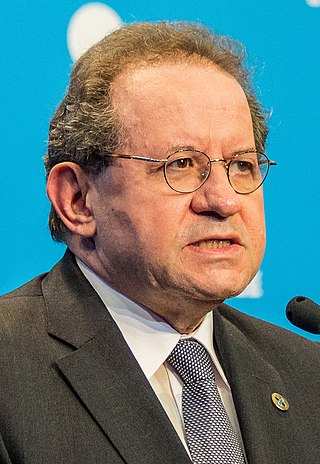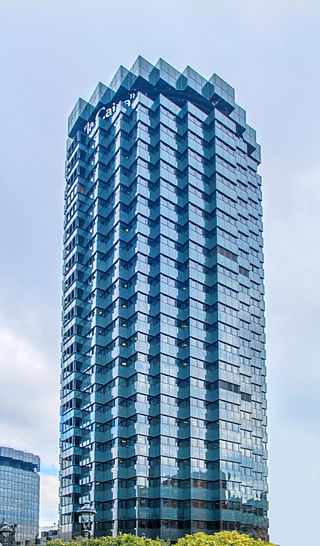
The Bank of Mexico, abbreviated BdeM or Banxico, is Mexico's central bank, monetary authority and lender of last resort. The Bank of Mexico is autonomous in exercising its functions, and its main objective is to achieve stability in the purchasing power of the national currency.

The Bank of Spain is the Spanish member of the Eurosystem and has been the monetary authority for Spain from 1874 to 1998, issuing the Spanish peseta. Since 2014, it has also been Spain's national competent authority within European Banking Supervision. It was originally established by Charles III in Madrid in 1782, as the Banco Nacional de San Carlos, and took its current name in 1856. It is also Spain's national competent authority within European Banking Supervision. Its activity is regulated by the Bank of Spain Autonomy Act.

Banco de Sabadell, S.A. is a Spanish multinational financial services company headquartered in Alicante and Barcelona, Spain. It is the 4th-largest Spanish banking group. It includes several banks, brands, subsidiaries and associated banks. It is a universal bank and specialises in serving small and medium enterprises (SMEs) and the affluent with a bias towards international trade.

The Central Bank of Cuba is the central bank of Cuba. It was created in 1997 to take over many of the functions of the National Bank of Cuba, which was established on 23 December 1948 and began operations on 27 April 1950.

Vítor Manuel Ribeiro Constâncio, GCC, GCIH is a Portuguese economist and academic who served as Vice President of the European Central Bank from 2010 to 2018. He previously served as Governor of the Bank of Portugal from 1985 to 1986 and 2000 to 2010.
The colón was the currency of El Salvador from 1892 until 2001, when it was replaced by the U.S. dollar during the presidency of Francisco Flores. The colón was subdivided into 100 centavos and its ISO 4217 code was SVC. The plural is "colones" in Spanish and the currency was named after Christopher Columbus, known as Cristóbal Colón in Spanish.

Emilio Botín-Sanz de Sautuola García de los Ríos,iure uxorisMarquess of O'Shea was a Spanish banker. He was the executive chairman of Spain's Grupo Santander. In 1993 his bank absorbed Banco Español de Crédito (Banesto), and in 1999 it merged with Banco Central Hispano creating Banco Santander Central Hispano (BSCH), which became Spain's largest bank, of which he was co-president with Central Hispano's José María Amusategui, until Amusategui retired in 2002. In 2004, BSCH acquired the British bank Abbey National, making BSCH the second largest bank in Europe by market capitalisation. He was known for his obsession with growth and performance as well as regularly visiting branches.
Equitable PCI Bank, Inc. was one of the largest banks in the Philippines, being the third-largest bank in terms of assets. It was the largest bank before it was overtaken by Metrobank in 1995. It is the result of the merger of Equitable Banking Corporation and Philippine Commercial International Bank or PCIBank. It was known for a wide range of services from savings to insurance and, through its wholly owned subsidiary Equitable Card Network, was the largest Philippine credit card issuer. The bank merged with Banco de Oro Universal Bank in early 2007, and is now branded as BDO as its new identity as part of the new Banco de Oro Unibank, Inc.

Banco Santander, S.A., doing business as Santander Group, is a Spanish multinational financial services company based in Madrid and Santander in Spain. Additionally, Santander maintains a presence in all global financial centres as the 19th-largest banking institution in the world. Although known for its European banking operations, it has extended operations across North and South America, and more recently in continental Asia. It is considered a systemically important bank by the Financial Stability Board.
This article discusses banking in Cuba and gives an overview of the recent past. For details on the Cuban economy in general, see economy of Cuba.

The Central Reserve Bank of El Salvador is the central bank of El Salvador, which controls the currency rate and regulates certain economic activities within El Salvador. The bank was originally privately owned, but was brought under state control through The Law on the Reorganization of Central Banking.

The Central Bank of Nicaragua is the central bank of Nicaragua.

CaixaBank, S.A., formerly Criteria CaixaCorp, is a Spanish multinational financial services company. CaixaBank is based in Valencia, with operative offices in Madrid and Barcelona, Spain. It is Spain's third-largest lender by market value, after Banco Santander and BBVA. CaixaBank has 5,397 branches to serve its 15.8 million customers, and has the most extensive branch network in the Spanish market. It is listed in the Bolsa de Madrid and is part of the IBEX 35.

Banco Occidental de Descuento (BOD) (WDB) was a Venezuelan bank. With around 6.6% of the Venezuelan market, it was Venezuela's fifth-largest bank in 2009.

The Banco de Portugal is the Portuguese member of the Eurosystem and has been the monetary authority for Portugal from 1846 to 1998, issuing the Portuguese escudo. Since 2014, it has also been Portugal's national competent authority within European Banking Supervision. The bank was founded by royal charter in 1846, during the reign of Queen Maria II of Portugal, by a merger of the Banco de Lisboa, the first bank founded in Portugal, and insurer Companhia Confiança Nacional.

BAC Credomatic is a financial group in Central America, with operations in Guatemala, El Salvador, Honduras, Nicaragua, Costa Rica, Panama, Grand Cayman, The Bahamas, and the United States.
BANADESA, or the National Bank for Agricultural Development, is a financial development bank in Honduras.

Carlos Fernández Valdovinos is a Paraguayan economist. Between October 2013 and August 2018 he was the president of the Central Bank of Paraguay.

Paul Vinelli was an Italian-American-Honduran economist and banker. He was sent to Honduras in 1949 by the International Monetary Fund to advise the government on banking and tax legislation. He was instrumental in the creation of the Central Bank of Honduras and the National Bank for Agricultural Development in 1950. He remained working as an economic advisor to the Honduran government for six years. In future years he continued to be one of the strongest guides of Honduran economic policy.


















